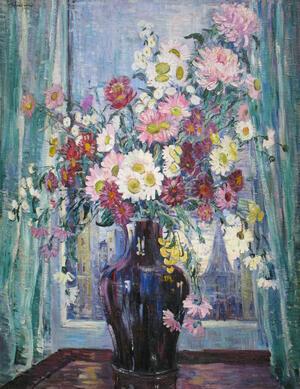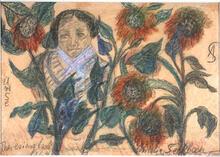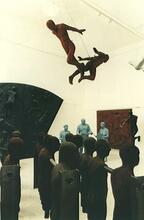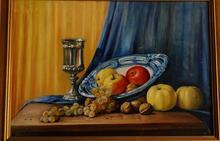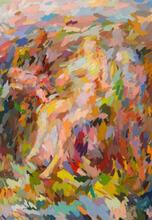Dorothea Litzinger
In her short life, Dorothea Litzinger earned a reputation as a promising painter for her vibrant screens, panels, and canvasses of vases full of flowers and flowering gardens. Litzinger studied at the Pratt Institute in New York, then spent two years at the National Academy of Design from 1908 to1910. She served as director of the Art Alliance and was a member of the Allied Artists of America, which offered juried exhibitions of gifted artists. Outside her work, she was also active in her community, chairing the Beekman Hill Association’s executive committee, which led a campaign to organize local children to clean up litter. She died of pneumonia weeks before her thirty-sixth birthday.
Article
An artist best known for her paintings of flowers, Dorothea Litzinger also painted landscapes, decorative screens, and panels. It is not apparent that her work reflected any connection with her Jewish background: Her choice of subject matter was completely in concert with acceptable norms for upper-class women who painted. In her art and social milieu, Litzinger appears to have lived a highly assimilated life. In the artist’s file at the New York Public Library, there is an invitation, dated March 1923, from Messrs. Kennedy and Company at 693 Fifth Avenue to a “special Easter Exhibition of decorative flower and landscape paintings by Dorothea Litzinger.” She was also involved in civic and community issues and served as chair of the executive committee of the Beekman Hill Association. In that capacity, she was credited with organizing neighborhood children in a campaign for “sanitary streets.”
Born in Cambria County, Pennsylvania, on January 20, 1889, Dorothea Litzinger studied art at the Margaret Morrison Carnegie School of Pittsburgh and at the Pratt Institute in New York. From 1908 to 1910, she attended the National Academy of Design. She was married to an attorney, John W. Thompson, although she was known solely as Dorothea Litzinger in all reference material, including her obituary in the New York Times.
Litzinger served as director of the Art Alliance and belonged to the Allied Artists of America, an organization established in 1914 as an exhibition cooperative that elected its own juries. As a member of the Connecticut Academy of Fine Arts, Litzinger participated in the annual exhibition at the Wadsworth Atheneum. She also belonged to the New Haven Paint and Clay Club. In 1924, Litzinger held a solo exhibit of her work at the Ralston Gallery in New York City.
In an article in Art News, “The Career of Dorothea Litzinger” (1925), Litzinger is described as “radiant, young and full of energy, never afraid of hard work.” Her paintings of flowers are referred to as “an expression of herself in the generosity of their color and richness of design.” Dorothea Litzinger was “an artist of intelligence and promise, always striving for something better, and could she have lived, would no doubt have attained great heights in her decorative painting.”
After a brief bout with pneumonia, Dorothea Litzinger died at her home on January 5, 1925.
AJYB 24:175.
Art News 23 (November 15, 1924): 6.
Litzinger, Dorothea. Clippings. Artist file, New York Public Library.
Collins, J.L. Women Artists in America; Judson, Alice. “The Career of Dorothea Litzinger.” Art News (June 1925).
Pettey, Chris. Dictionary of Women Artists; NYTimes, March 2, 1924, 8:10.
Obituary. NYTimes, January 6, 1925, 25:4.
Who Was Who in American Art.

